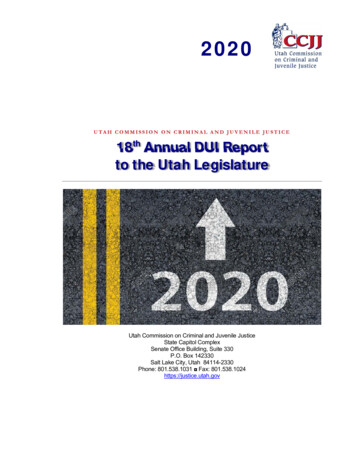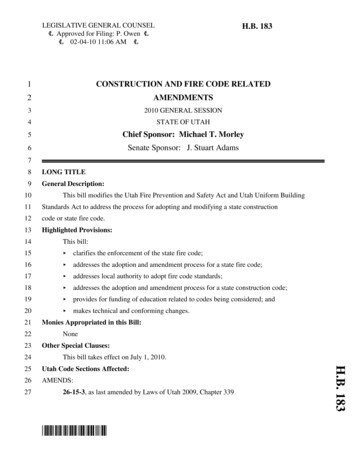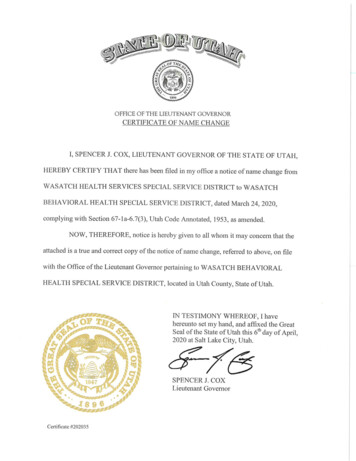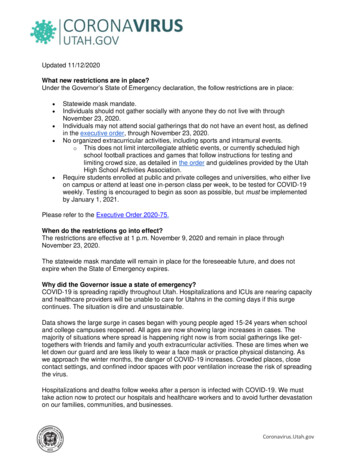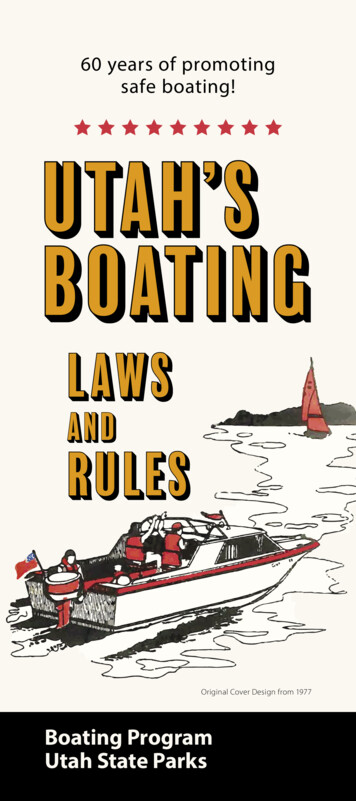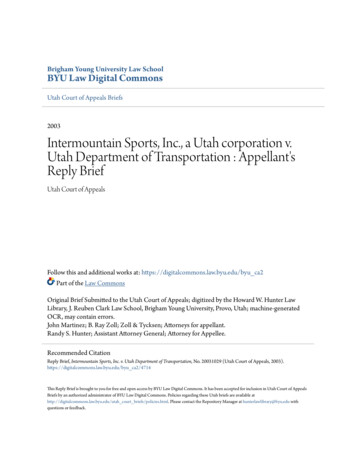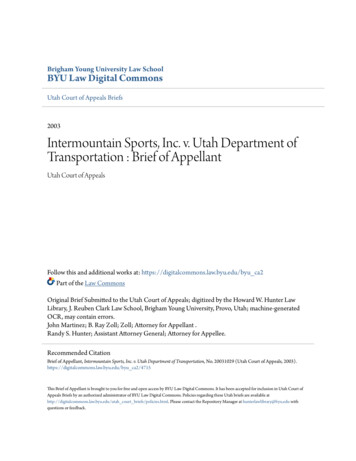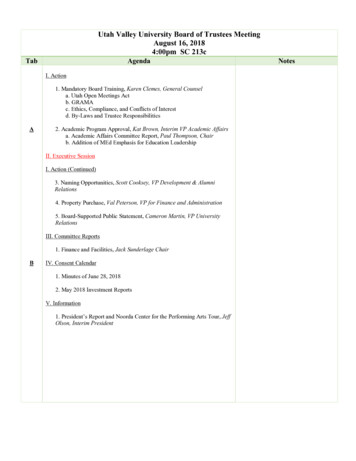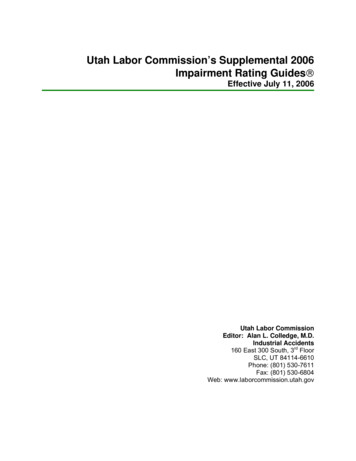
Transcription
Utah Labor Commission’s Supplemental 2006Impairment Rating Guides Effective July 11, 2006Utah Labor CommissionEditor: Alan L. Colledge, M.D.Industrial Accidents160 East 300 South, 3rd FloorSLC, UT 84114-6610Phone: (801) 530-7611Fax: (801) 530-6804Web: www.laborcommission.utah.gov
Utah Labor Commission’s 2006 Supplemental Impairment Rating Guides 5/12/2006This guide is to be used for all impairment ratings done in Utah and is a supplement to the AmericanMedical Association’s Guides to the Evaluation of Permanent Impairment 5th Edition, (hereafter referred toas the AMA Guides) for workers’ compensation purposes. It is to clarify the definitions and practicescontained in the AMA Guides from a unique workers’ compensation context. The purpose of this work isto add more refinement and uniformity to the impairment process. It is produced by medical providersskilled in occupational medicine and impairment rating for workers' compensation, with input fromregulators and benefit administrators. To provide rating methodology that facilitates consistencythroughout the Guides, the Utah impairment committee reviewed, simplified and updated these guideswithin the Functional, Anatomic, and Diagnostic model as listed in the spine, upper and lower extremitychapter.AcknowledgmentsThe report is the result of many dedicated people who want to improve the functioning of the workers'compensation system. In particular, the contributors share a passion for delivering fair compensation toinjured workers in Utah. Fairness has many dimensions, but this committee has a particular interest in,and competency on, the reliable and valid measurement of bodily impairments due to work injury.This handbook is produced by the Utah Labor Commission’s Impairment Rating Committee. Since itscreation in 1993, this committee has been led by Alan L. Colledge, MD, Medical Director of the LaborCommission. Special thanks are extended to the following individuals who played a particularly importantrole in the drafting and publishing these Utah 2006 Impairment Guides:Chairs:Alan Colledge, MDJoyce Sewell, MPAContributors:Dawn Atkin, Applicant AttorneyJoel Dahl, MD, PhysiatristBart Fotheringham, MD, PhysiatristEdward B. Holmes, MD, MPH, Occupational MedicineJonathan Horne, MD, Orthopedic SurgeonGregory Krohm, Executive Director, IAIABCDouglas Shepherd MD, PhysiatristRoger Stuart, MD, Occupational MedicineEric Vanderhooft, MD Orthopedic SurgeonReviewers:Dennis Gordon MD, Orthopedic SurgeonPeter Grosebeck, Labor CommissionRichard Johns, MD, MPH, Occupational MedicinePat Luers, MD, RadiologistBruce Newton, MD, PhysiatristDaniel S. Sellars, MD, Plastic Surgeon, Hand SpecialistsThomas Sturdy, Defense Attorney
Utah Labor Commission’s 2006 Supplemental Impairment Rating Guides 5/16/2006Table of ContentsChapter One: 1.2d.i.1.2d.ii.1.2d.iii.1.2d.iv.1.2e.1.2 f.1.2g.1.2h.1.2 i.1.31.3a.1.3b.1.3c.1.3d.1.3e.1.3 f.1.4SubjectIntroductionUtah GuidesAmerican Medical Association Impairment GuidesPage123Legal and Historical BackgroundOverview of Occupational BenefitsSchedule 1: Workers’ Compensation Cases in the United States, 2000Measuring Permanent Loss from InjuryImpairment/Disability Relationship in Workers’ CompensationMedical Care ResponsibilityMedical Care Evidence Needed in the Calculation of Impairment RatingsProblems with Impairment Ratings33445668General Guidance for RatersDuties of Rating Physician or RaterWhat Metric to Use?Medical Report at StabilityReporting of Impairment RatingsDiagnosisStabilityCalculation of ImpairmentApportionmentTime Periods for Certain Conditions to Reach Medical StabilityCapabilities AssessmentFuture Medical TreatmentImpairment Ratings for Conditions Not Found in the Utah 2006 Edition or the AMA5th EditionImpairment Rating for those Patients who Decline Surgical, Pharmacological, orTherapeutic Treatment of an Impairment99910101010111111111212Administrative IssuesWho Is to Perform Impairment RatingsFormsBilling for Impairment RatingsBilling for Impairment Ratings Done by the Treating PhysicianSchedule 2: Current Existing Non-specific Procedure Codes that Can Currentlybe Utilized When Submitting Billings for Impairment Rating ProceduresSchedule 3: Billing for Impairment Ratings Done by Someone Other than theTreating PhysicianGeneral Rules for Calculating Impairment RatingsRules for When to Combine and When to Add Impairment Values121313131313Summary to Chapter One1512141414Page 2
Utah Labor Commission’s 2006 Supplemental Impairment Rating Guides 5/12/2006Chapter Two: Pain and i.2.0a.iv.SubjectPainPain Rating Guidelines and Examples of ApplicationPost Traumatic Head SyndromeGlasgow Coma ScaleExamples of Extraordinary Pain SyndromesFunctional Somatic Syndromes that are Not Characteristic of any WellRecognized Medical DisorderPage1616171718182.12.1a.Utah’s Chronic Regional Pain Syndrome (CRPS) Type 1 or 2Calculation of Impairment Rating in Utah18182.22.2a.2.2b.ApportionmentWhen and How Impairment Benefits are ApportionedThe Schedule to Use When Apportioning Preexisting ConditionsSchedule 4: What Schedule to Use When Apportioning Prior Ratable Conditions19202021Chapter Three: Spinal Injuries and onPage22Spine and Pelvis ConditionsApportionment of Soft Tissue ImpairmentSpine Impairment Concepts222323Spinal Translocation, or Isolated Spinal Segmental Instability (ISSI)243.33.3a.3.3b.3.3c.3.3d.3.3e.3.3 f.3.3g.3.3h.3.3 i.SchedulesSchedule I. Soft Tissue – Non Surgically Treated Spine ConditionsSchedule II. Surgically Treated Spine ConditionsSchedule III. Radiculopathy ScheduleSchedule IV. Vertebral FracturesSchedule VI. Severity Indexing For Apportionment of Schedule IProcess to Apportion from Schedule ISchedule V. The PelvisSchedules Vx for Calculating Neurological LossSpine with Associated Severe Neurological Injuries242526272829303131323.43.4a.3.4b.Schedule FormsForm for Computing Spinal Impairments – Schedule IForm for Computing Surgical Spinal Impairments – Schedule II3233343.2Page 3
Utah Labor Commission’s 2006 Supplemental Impairment Rating Guides 5/12/20063.5Examples of Spine Impairment35Example 1: Mechanical Back PainExample 2: Mechanical Back PainExample 3: Mechanical Back PainExample 4: Mechanical Back Pain With Referred PainExample 5: Mechanical Back Pain With Referred Pain And With Prior HistoryExample 6: Cervical-Thoracic Pain Without RadiculopathyExample 7: Cervical-Thoracic Pain Without Radiculopathy And With ClinicalManifestations Of Overt Pain BehaviorsExample 8: Low-Back Pain With Radiculopathy (No Surgery)Example 9: Low-Back Pain (Post-Surgery)Example 10: Low-Back Pain With Radiculopathy (Post-Surgery)Example 11: Low-Back Pain With Foot Drop (Post-Surgery)Example 12: Spondylolisthesis Without HistoryExample 13: Spondylolisthesis With Radiculopathy And Without Prior HistoryExample 14: Spondylolisthesis With Radiculopathy And With Prior HistoryExample 15: Prior History Of Disc Problems Requiring Surgery And Now With ARecurrent Disc Herniation, Needing Another SurgeryExample 16: Second Disc Injury, Treated Non-OperativelyExample 17: First Industrial Disc Injury, Second Disc Herniation Requiring A SecondSurgeryExample 18: Disc Injury, Undergoing Three Surgeries, Including A FusionExample 19: Degenerative Disc Disease With Two-Level DecompressionExample 20: Compression Fractures With Prior History And RatingExample 21: Burst Fracture Requiring FusionExample 22: CoccygodyniaExample 23: Prior Non-Industrial Injury With Two Industrial Injuries And RatingsExample 24: Prior Industrial Rating With Another System, Now With A New InjuryExample 25: Prior Industrial Rating With Another System, Now With A New InjuryExample 26: Impairment Related To One Event And Operation On Two DiscsExample 27: Impairment Related to Fractured PelvisExample 28: Impairment Related to Percutaneous Discectomy at 2 505152535454Chapter Four: Upper ExtremitySection4.04.14.1a.SubjectIntroduction to Upper ExtremityPage562006 Utah Upper Extremity Rating Guidelines WorksheetSchedules in AMA 5th Edition Not to Be Used for Rating Impairments in the UpperExtremityPeripheral Nerve Tables to be Used - Sensory DeficitsMotor Deficits57574.2Utah’s Chronic Regional Pain Syndromes Type 1 or 2 for Upper Extremities594.3Upper Extremity Ratings for Shoulder Conditions59Utah’s Upper Extremity Neuro-Muscular ImpairmentsConstrictive TenosynovitisPeripheral Nerve EntrapmentNerve Entrapment: Near the ElbowApplication of the Nerve Entrapment 858Page 4
Utah Labor Commission’s 2006 Supplemental Impairment Rating Guides 5/12/20064.4e.4.4 f.4.4g.4.4h.4.5Guidelines for Placement of Patients within Schedule VIIIUtah’s Specific Upper Extremity Impairments Due to Entrapment NeuropathySpecific Upper Extremity Painful Organic SyndromesUtah’s Specific Upper Extremity Painful Organic Syndromes61626263Examples of Upper Extremity Impairment RatingsExample #1: Rotator Cuff RepairExample #2: Shoulder Fracture636465Chapter Five: Lower ExtremitySection5.0SubjectIntroduction to Lower Extremity: AMA 5th Edition Chapter 17Page675.15.1a.5.1b.Motor Deficits worksheetCRPS for Lower Extremity2006 Lower Extremity Rating Guidelines Worksheet6869695.25.2a.5.2b.Lower Extremity Arthroscopic Cartilaginous ImpairmentsSpecific Lower Extremity Painful Organic SyndromesUtah’s Specific Lower Extremity Painful Organic Syndromes7070705.35.3a.5.3b.5.3c.5.3d.Examples of Lower Extremity Impairment RatingExample #1Example #2Example #3Example #47171727374Chapter Six: Miscellaneous Impairments and ClarificationSectionSubjectPageth6.0Miscellaneous Impairments and Clarification Statements for the AMA 5Edition766.1Loss of Teeth Secondary to an Industrial Event776.2Temporomandibular Joint776.3Utah’s Burn Impairment Methodology776.4Example: Burn816.5Utah’s 2006 Clarification of the AMA Guides to the Evaluation of PermanentImpairment 5th Edition826.6Glossary of Terms: Definitions of clinical findings accepted by the UtahGlossary of Terms86References89Page 5
Utah Labor Commission’s 2006 Supplemental Impairment Rating Guides 5/12/2006Chapter One: Introduction1.0 IntroductionThe concept of compensating people for injuries received “on-the-job” has been present for many years.Even pirates who roamed and plundered in the 7th Century had their own elaborate code of“compensation.”1 It wasn't until the early 20th century that “workers' compensation” became a legislatedright in the United States. Each jurisdiction has been designed to ensure the worker prompt, but limitedbenefits and to assign to the employer sure and predictable compulsory liability insurance withestablished parameters. The principal components that have received legislative expression in allsystems include: (1) A statutory program. (2) Expeditious resolution of disputed issues. (3) Limited liabilitywithout fault: (Since workers' compensation is a no-fault insurance program, determining negligence orblame is often irrelevant). (4) Automatic benefits which include: (a) Medical treatment coverage including:medical care, services and supplies as necessary to cure or relieve the effects of an on the job injury.This means that the employee does not incur any deductible or out-of-pocket expense for the medicaltreatment of a work-related injury or illness. (b) Indemnity payments replacing wages while the injuredemployee recovers from an industrial injury and/or reaches medical stability. All states have varyingformulas for the calculation of these indemnity payments, which are often tax-free. (c) Death benefits,providing weekly payments to the surviving spouse and dependent children of a worker whose workrelated injury result in death. Burial and funeral expenses are also paid. (d) An impairment settlementgiving compensation to an injured worker for permanent physical loss from a work-related injury (i.e.,scars, disfigurement, amputation, etc.), according to a defined compensation schedule. The mostseverely injured workers are those who are left with some permanent loss, qualifying for an impairmentrating.In some countries, government insurance programs cover occupational and non-occupational disabilitywith the same administrative and benefit laws. However, in other countries, particularly Australia,Canada, and the United States, workers’ compensation uses its own distinct approach to thecompensation of occupational disability. By 1949, all 50 states had adopted some form of workers’compensation legislation.2 The scope and amount of payments for these agreed upon services aredetermined by the individual state and in some cases by federal law. In these places where separateworkers’ compensation laws exist, there is commonly a legal process for qualifying and quantifyingcertain injuries for a class of benefits for “permanent disability.” This process is distinct from other socialinsurance programs covering disability, private disability insurance, or damage measurements made inconnection with civil legal proceedings. Thus, the measurement of total disability for US Social Securitydisability qualification has no relation whatsoever to a permanent total disability rating in workers'compensation. Private disability insurance claims adjusters, while they may ask about permanentphysical loss, are mainly concerned with vocational and job performance issues.Workers’ compensation is a system based on a heterogeneous collection of national and sub-national(individual state and provincial) laws. There are no binding national or international standards for howworkers' compensation impairment ratings are to be done. A few programs are listed to illustrate the widerange of government insurance systems in the United States alone that have their own rating systems foroccupational disability: Black Lung BenefitsLongshoreman and Harbor Workers ProgramRailroad Workers ProgramVeterans BenefitsFederal Employees Compensation Act (civilian)Knowing that it has its own distinct system, with enforced rules of adjudicating claims, may prevent thephysician/rater from consciously or unconsciously misapplying techniques or methods used for evaluatingother kinds of permanent injury or disability. This guide focuses on issues specific, or particularlycommon, to an occupational injury.Page 1
Utah Labor Commission’s 2006 Supplemental Impairment Rating Guides 5/12/2006Physicians who make impairment ratings should understand the basic and universal principles of workers’compensation law to respond to the clinical and procedural demands of rating the permanent residualconsequences of work-related injury or disease. This introduction covers this essential background. Inaddition, it explains the purposes and use of this supplemental guide.Studies have shown that those who incur impairments have a significant impact on their future wageincome.3 4 5 As with the other benefits, there are significant differences between the states on the valueof settlement amounts and the methodology utilized to calculate total disability benefits.6 7 8The inconsistencies inherent with current rating systems used to calculate injured worker’s residual lossor impairment can be frustrating for patients, physicians, risk managers, state administrators andpayors.9 One of the major problems with impairment ratings is the lack of consistency between physicianraters of impairments.10 11 12 Unfortunately, this variability becomes a source of dispute, which is bothcostly to the employer, insurer, and state regulator and stressful to the employee.Reducing variability in calculating impairment ratings has significant benefits to the workers’compensation system including: Greater equity across injured workers, regardless of who rated their impairment.Speedier payments to workers because of fewer questions and challenges by claims adjusters.Resolution of injured workers frustrations, which facilitates the moving forward with their lives.Fewer disputes and litigation because the rules for calculating an impairment rating are clear andconsistently applied.Lower administrative costs.Comparable statistics permitting jurisdiction comparisons, tracking, and research.Evolution of an international standard for jurisdictions to consider.The AMA Guides, for reasons explained below, fall short of a guide for workers' compensation. Indeed,there is much diversity among the states in the fundamentals of how and when benefits should be paid.This is especially true concerning approaches to measuring and compensating the injured worker for thelasting, or permanent consequences of an industrial injury.1.0a. Utah’s GuidesThe Utah Guide and the AMA Guides are tools that can be used to convert medical information aboutpermanent losses into numerical values i.e., impairments. These impairment values are to be used forpermanent rating purposes only and are not to be used for causation determinations. As the long list ofcritical papers in the literature will attest, the calculation of impairment is not an objective science and isbased largely on consensus rather than scientific evidence (Holmes, 2002,Gloss & Wardle, 1982; Disler,Battrass & Nischke, 1999; Clark et. al, 1988). Many US states, including Utah, do not recognize thecomplete AMA Guides for rating impairment, and have instead developed their own internal standards orguides for raters.Below is a brief introduction to the AMA Guides, followed by a statement of how this supplement interactswith impairment rating guides published by the AMA. In 1993, the Labor Commission’s Workers’Compensation Advisory Council commissioned the Impairment Rating Committee to address the needs ofworkers' compensation claims payers and system administrators in rating permanent impairment. It wasbelieved that by improving the rating criteria physicians were required to utilize would reduce variability forthe impairment ratings. It was also noted that experience and a certain skill level was necessary toaccurately and consistently calculate impairment ratings. The Committee’s mission was to evolve towardthe best practices in rating methodology. It was not the committee’s purpose to be unduly critical of theexisting impairment systems, as all attempts to classify and communicate about this rather complicatedproblem, are fraught with difficulty. However, the inherent weaknesses necessitated the development ofPage 2
Utah Labor Commission’s 2006 Supplemental Impairment Rating Guides 5/12/2006a system, which represented current medical science and was as objective as possible, given currenttechnological limitations. In 1994, after reviewing different rating systems, utilizing examples and differentunique models, the committee developed and the state of Utah adopted the American MedicalAssociation’s 4th Edition of the Guides, with a completely new Utah impairment rating system to be usedin place of the AMA Guides. These guides were updated in 1997 and again in 2001 clarify ratings forspinal conditions, upper-extremity peripheral neuropathies, temporomandibular joint dysfunction, dentalloss and painful upper and lower extremity conditions.13 Since adopting these Utah impairment guides, itis estimated that litigation over impairment ratings has reduced to less than 1%.14 This reduction oflitigation has assisted in making Utah the least costly state in the nation for a manufacturer to obtainworkers’ compensation insurance,15 while maintaining the medical fee schedule above the nationalaverage.16 Additional supplemental bulletins or guides were expected to be periodically issued asmedical science and the AMA Guides evolve.1.0b. American Medical Association Impairment GuidesOriginally published as a series of articles in the Journal of the American Medical Association, the AMAGuides have been revised periodically, and are now in the 5th Edition. As shown in Appendix A, 35 USstates reference some version of the AMA Guides in their workers’ compensation law (Brigham, 2002).Other sources site a slightly different usage (AMA, 2000; Bavon, 1993).Most jurisdictions that utilize some edition of the AMA Guides for injured workers’ impairment ratings noteunnecessary physician/rater reporting variability in the impairment rating for what appears to be the samephysical loss. This variability creates unnecessary patient anger, suspicion, hostility, litigation, and costs.Regarding impairment ratings, this variability is attributed to several non-medical factors. These factorsinclude the individual examining physician’s lack of knowledge or skills, difficulties in differentiatingsubjective complaints from objective findings, confusion between the concepts of impairment anddisability, bias, poor quality medical reports, difficult causation analysis questions, and the apportionmentprocesses. Members of the Utah Occupational Impairment Rating Guide Committee believe that byimproving the rating criteria requirements, physicians/raters can improve fairness and resolution forinjured workers, reduce variability and thus reduce unnecessary overall expense to the regulators, payorsand the patient for the impairment ratings.1.1 Legal and Historical BackgroundProviding claims information can be extremely frustrating and time consuming for physicians/raters andtheir support staff. This section reviews legal and administrative issues to equip physicians and theirstaffs to better respond to the demands made on their time and medical expertise by disability andworkers' compensation claims processors. It explains benefit types and nomenclature.1.1a. Overview of Occupational BenefitsThe categories listed below describe the four broad divisions of claims and their common abbreviationsfor benefits payable under Utah workers' compensation. Medical-only Temporary disability, for wage loss indemnity (TTD) Permanent disability, divided into Permanent Total (PT) and Permanent Partial Impairment (PPI) Death (including burial)Most workers’ compensation injuries require only medical attention and do not involve lengthy time awayfrom work, nor do they leave residual effects on the worker. In the United States, “medical-only claims”are about 72 percent of all compensable injuries (Telles, 2001). These are claims that do not involvecompensation for lost work time, only medical expenses related to an injury. The percentage of medicalonly claims is a function of the quality and speed of medical care, the length of lost time required beforePage 3
Utah Labor Commission’s 2006 Supplemental Impairment Rating Guides 5/12/2006an injury qualifies for indemnity benefits, and how scrupulously employers report claims as workers'compensation.Under Utah’s workers’ compensation law, when the injured worker has missed 3 days of time from work,he/she is eligible for wage indemnification, with the amount determined a set state formula. Wage lossbenefits continue until the disabling condition either permits a return to work, or reaches a plateau wherehealing ends and no significant improvement is likely. When this occurs, the injured worker may beentitled to another class of benefits to compensate for any permanent residual loss, i.e., PPI.The cost for providing the monetary loss for residual impairments is substantial. As Table 1 below shows,about a quarter of claims in the United States involve permanent injury benefits, yet they produce abouttwo thirds of the cash benefits paid. Of the 25.3 billion in cash benefit payments going directly to injuredworkers in 1999; nearly 19 billion were for compensation of permanent injury.Schedule 1Workers’ Compensation Cases in the United States, 2000Type of Workers’Compensation ClaimTemporaryPermanent PartialPermanent TotalPercentage ofCases72%271Percentage ofCash Benefits25%6213Source: National Academy of Social Insurance,Workers’ Compensation: Benefits, Coverage, and Costs, May 2001In summary, several different classes of benefits are paid under workers' compensation. Permanentinjury claims account for a very large share of benefits paid. These benefits are largely controlled bymedical judgments made by physicians and communicated in reports to claims adjusters and workers'compensation administrators. Physician-raters must be cognizant that Utah statutes administrative rules,and case law are Utah specific and at times may seem impractical as one reviews the relative severity ofinjury for purposes of quantifying benefits to be awarded for permanent injury.1.1b. Measuring Permanent Loss from InjuryThe impairment rating process for workers' compensation is part of a larger process of claim adjudication.Medical issues and reports drive the settlement of most claims. The medical issues can be divided intothree phases:1.2.3.4.Verifying that a specific injury or disease has occurred.Providing information to help establish the causation of the injury.Measuring the permanent residual losses secondary to the injury.Establishing the worker’s capability.Number 3 is technically referred to as “impairment rating” and number 4 latter as “disability rating.”Confusion between the two concepts is rampant.Some of the varying definitions of “impairment” found in the literature: Alteration of an individual’s health status that is assessed by medical means (J.B. Moore,Disability Systems).A medical assessment of a patient’s physical or anatomical deficit or loss use of function,represented by a percentage value for each deficit or functional loss, expressed in terms of thewhole person (Gerald Lipinsky, “Spinal Impairment and Disability”).Alteration of an individual’s health status; a deviation from normal in a body part or organ systemand its functioning (AMA Guides, 5th Edition).Page 4
Utah Labor Commission’s 2006 Supplemental Impairment Rating Guides 5/12/2006 Any loss or abnormality of psychological, physiological or anatomical structure or function.(World Health Organization).An impairment that results from anatomical, physiological, or psychological abnormalities, whichcan be shown by medically acceptable clinical and laboratory diagnostic techniques (US SocialSecurity Administration).Disability rating, on the other hand, measures a patient’s inability to perform specific and important activityof daily living or work. In some contexts this might be ordinary household tasks, in others, schoolwork.For occupational disability the focus is on:1. The tasks that the patient was previously able to do in their job or profession, and, if pre-injurywork is impossible,2. The alternative tasks that a person might perform.Disability and Impairment seldom match closely. Classic examples of the lack of correspondence ofphysical and economic/job limits are: A piano player losing a little finger would be rated at 5% percent whole person impairment.He/she may also be rated as 100% disabled for the preinjury occupation, and 50% disabled froma loss of earning capacity (because there are other related careers). A physician could lose thesame finger, be rated at 5% whole person impairment, and yet have little or no impact on his/herearning capacity.An attorney could lose his or her eyesight and receive a total impairment rating in a given system.Yet, with proper accommodation, he/she might not lose his/her preinjury job, or suffer any loss ofincome.A given physical loss would have dramatically different effects on a worker depending on: OccupationEducationAgeLanguage skillsGeographical opportunitiesEmployer’s flexibility to modify job dutiesOne of the ongoing challenges in workers’ compensation is to define how permanent physical loss iscalculated in a defensible and consistent way. The AMA Guides is the most common methodologyutilized to calculate impairment.1 The AMA Guides adopt the widely accepted view that impairment is adeviation in a body part or organ system and its functioning. Impairment is not equivalent to disability.The consequences of any given limitation are difficult to generalize to the whole working population.Moreover, these consequences may differ dramatically from what the injured worker was able to dobefore the injury. Similarly, how these consequences relate to other jobs, other activities of daily life, orpersonal happiness varies considerably.1.1b.i. Impairment / Disability Relationship in Workers' CompensationAn impairment rating is the threshold determinate for certain benefits needed to calculate the financialcompensation for the residual deficits from the injury or event, after an injured worker reaches medicalstability.1Some jurisdictions have separate processes for: (1) making a finding of impairment, and (2) calculating the impairment rating.Findings of impairment are done by physicians/raters. Insurers then rate the impairment by applying state adopted rating standardsto the findings. Thus, the technical aspects of coming up with an impairment “score” for benefit calculation is an administrativefunction.Page 5
Utah Labor Commission’s 2006 Supplemental Impairment Rating Guides 5/12/2006An injured worker must receive an impairment rating within six years of an injury or file an application for ahearing to hold a claim open for 12 years from the date of injury (see Glossary).1.1b.ii.Medical Care ResponsibilityMedical care for a workplace injury continues for the life of the claimant so long as the claimant sees aphysician who bills the carrier/employer at least once every 3 years.1.1b.iii. Medical Evidence Needed in the Calculation of Impairment RatingsThe goal of the 2006 Utah Guides is to improve the uniformity and accuracy of impairment ratings. Thestandard impairment schedule considers percentage of loss on an arbitrary continuum, with 0% reflectingno residual or loss and 100% whole person impairment equaling a state approaching death. As anexample, a complete amputation of the ring or little finger equals 5% whole person im
Utah Labor Commission's Supplemental 2006 Impairment Rating Guides Effective July 11, 2006 Utah Labor Commission Editor: Alan L. Colledge, M.D. Industrial Accidents 160 East 300 South, 3rd Floor SLC, UT 84114-6610 Phone: (801) 530-7611 Fax: (801) 530-6804 Web: www.laborcommission.utah.gov
